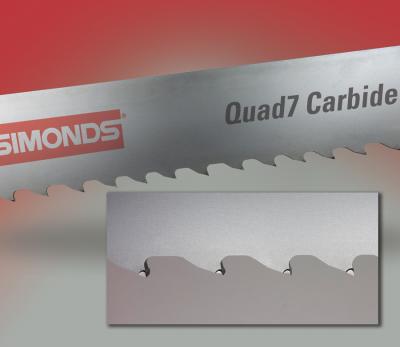
Simonds Saw introduces QUAD 7 carbide-tipped bandsaw blades for demanding production cutting operations, such as steel service centers, foundries and aerospace sawing applications. QUAD 7 blades are suitable for alloy; high chrome alloy; Inconel and other nickel-based alloys; titanium block and plate; stainless steels; and mold, tool and bearing steels.
QUAD 7 Blades feature a positive rake angle, four-tooth pattern that produces seven distinct chips. This provides exceptionally high material penetration for faster cutting in production sawing alloy applications, according to the company.
“With today’s increased use of exotic alloys in production sawing, the need for more aggressive cutting solutions is pronounced. Our innovative QUAD 7 tooth pattern was developed to address this and customers have responded very positively to initial testing,” said Dale Petts, Simonds Saw’s global product manager.
Simonds QUAD 7 carbide-tipped blades are available in five widths: 3/4” x .050, 1-1/2” x .050, 2” x .062, 2-5/8” x .062 and 3-1/8” x .062 and are shipped in 150’ coils. Variable tooth pitch (TPI) options include 2.5-3.5, 2-3, 1.9-2.1, 1.4-1.8, 1.1-1.4, and .9-1.1 teeth per inch. Blades are furnished with plastic capping to protect teeth against damage in transit and handling.
Contact Details
Related Glossary Terms
- alloys
alloys
Substances having metallic properties and being composed of two or more chemical elements of which at least one is a metal.
- bandsaw
bandsaw
Machine that utilizes an endless band, normally with serrated teeth, for cutoff or contour sawing. See saw, sawing machine.
- centers
centers
Cone-shaped pins that support a workpiece by one or two ends during machining. The centers fit into holes drilled in the workpiece ends. Centers that turn with the workpiece are called “live” centers; those that do not are called “dead” centers.
- pitch
pitch
1. On a saw blade, the number of teeth per inch. 2. In threading, the number of threads per inch.
- rake
rake
Angle of inclination between the face of the cutting tool and the workpiece. If the face of the tool lies in a plane through the axis of the workpiece, the tool is said to have a neutral, or zero, rake. If the inclination of the tool face makes the cutting edge more acute than when the rake angle is zero, the rake is positive. If the inclination of the tool face makes the cutting edge less acute or more blunt than when the rake angle is zero, the rake is negative.
- sawing
sawing
Machining operation in which a powered machine, usually equipped with a blade having milled or ground teeth, is used to part material (cutoff) or give it a new shape (contour bandsawing, band machining). Four basic types of sawing operations are: hacksawing (power or manual operation in which the blade moves back and forth through the work, cutting on one of the strokes); cold or circular sawing (a rotating, circular, toothed blade parts the material much as a workshop table saw or radial-arm saw cuts wood); bandsawing (a flexible, toothed blade rides on wheels under tension and is guided through the work); and abrasive sawing (abrasive points attached to a fiber or metal backing part stock, could be considered a grinding operation).
- sawing machine ( saw)
sawing machine ( saw)
Machine designed to use a serrated-tooth blade to cut metal or other material. Comes in a wide variety of styles but takes one of four basic forms: hacksaw (a simple, rugged machine that uses a reciprocating motion to part metal or other material); cold or circular saw (powers a circular blade that cuts structural materials); bandsaw (runs an endless band; the two basic types are cutoff and contour band machines, which cut intricate contours and shapes); and abrasive cutoff saw (similar in appearance to the cold saw, but uses an abrasive disc that rotates at high speeds rather than a blade with serrated teeth).
